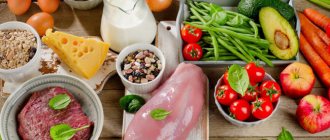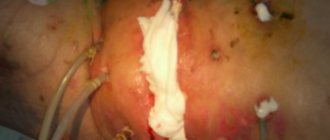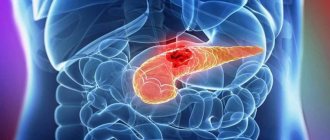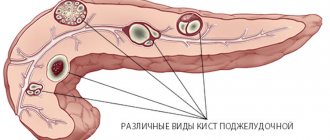Pancreatitis is a disease of the pancreas associated with the development of an inflammatory process in the organ. With this disease, there is a disruption in the flow of enzymes involved in digestion from the pancreas to the duodenum. Digestive enzymes remain in the gland itself and destroy it. The main cause of this disease is improper and unbalanced nutrition. That is why the treatment of pancreatitis is based on a properly selected diet.
General rules. Duration of the diet.
Maintaining proper nutrition is the key to a quick recovery. With this diet, you must adhere to certain rules to eliminate the possibility of complications.
General diet rules:
- Overeating should be avoided
- Meals should be fractional, at least 5-6 times a day
- Food should be warm. It is necessary to completely exclude hot and cold foods.
- Eliminate raw vegetables and fruits and fiber-rich foods from your diet.
- Food should only be prepared using recommended methods.
Symptoms of pancreatitis
Main symptoms of pancreatitis :
- Feeling of fullness in the stomach after eating.
- Pain in the navel area.
- Constant heartburn, bloating and flatulence.
- Nausea.
- Bad breath.
- Belching.
- Swelling of the face (read a useful article on how to quickly get rid of swelling on the face).
- Fat stool.
- Dry skin.
- Redness of the skin.
In addition, a large number of toxins accumulate in the body, which can poison the body.
Nutrition for pancreatitis during exacerbation:
In case of exacerbation of pancreatitis, it is necessary to avoid eating any food for several days. During fasting, it is recommended to drink purified still water. The daily volume of water should be no more than 1.5-1.7 liters. After the pain and symptoms subside, you can add low-calorie food in small quantities to the diet (liquid cereals, vegetable soups, steamed fish or chicken cutlets).
If you do not follow a diet during acute pancreatitis, the disease can quickly become chronic.
Notice!
During the acute period, sanatorium-resort treatment is contraindicated: it is better to go to a hospital.
If you have a chronic
form, then you should regularly
carry out preventive treatment
.
Factors of occurrence and symptoms of pancreatitis
The course of pancreatitis is characterized by constant relapses, which occur due to the release of insufficient amounts of hormones and enzymes. The point is not even in constant relapses, but in the fact that with each subsequent one the condition worsens. The tissues are gradually destroyed, which subsequently threatens serious health problems.
It is very important to remember that inflammation of the pancreas can indicate the independence of the disease, or be a manifestation of other pathologies (liver cirrhosis, alcohol intoxication or atherosclerosis).
List of permitted products:
| Cereals (buckwheat, oatmeal, rice, semolina) | The cereal must be boiled in water, followed by the addition of milk and a small amount of butter. |
| vegetables | Vegetables can be consumed as first courses (vegetable soups, puree soup) or in the form of chopped boiled pieces. Allowed fruits include potatoes, carrots, green peas, zucchini, pumpkin, beets and cauliflower. |
| fruits | Raw fruits should not be eaten. You can eat fruit jams, marshmallows, baked apples, compotes, and jelly. |
| meat | You can eat lean meats: beef, veal, rabbit and chicken. The meat is steamed and prepared in the form of soufflés or minced meat cutlets. |
| fish | Steamed white river fish is allowed in the food. |
| egg | Allows you to prepare a steam omelet from 1 chicken egg or 3 quail eggs. |
| Dairy | Dairy products should have minimal fat content |
| bread | You can eat a small amount of wheat bread 2-3 days old |
Menu for the week
When creating a menu, it is advisable to diversify the daily set of products as much as possible so that a patient with pancreatitis does not experience a lack of individual nutrients. To do this, it is advisable to use products from different groups daily, prepare them in different ways and combine them in different ways. See below for an example of such a menu for the week.
Menu for Monday
Breakfast - liquid semolina porridge with milk diluted with water, weakly brewed tea.
Second breakfast - mashed cottage cheese, a slice of dried bread with a spoonful of fruit jelly, rosehip infusion.
Lunch - creamy pumpkin soup with cream, minced sirloin cutlet, tea.
Afternoon snack - protein omelet with a spoonful of sour cream, compote.
Dinner - carrot puree with cream, meatballs, tea with milk.
Before bed - a glass of acidophilus.
Menu for Tuesday
Breakfast - pureed rice porridge with butter, tea.
Second breakfast - jelly, biscuits.
Lunch - soup with pureed vegetables, meatballs with pureed buckwheat porridge, compote.
Afternoon snack - fruit soufflé, rosehip infusion.
Dinner - fish cutlet, mashed potatoes, tea.
Before going to bed - pureed cottage cheese.
Menu for Wednesday
Breakfast - oatmeal porridge with milk, compote.
Second breakfast - soft-boiled egg, pumpkin juice.
Lunch - cream soup of vegetables, meat soufflé, jelly.
Afternoon snack - cottage cheese casserole, rosehip infusion.
Dinner - minced meat roll with vegetables, tea with milk.
Before bed - yogurt.
Menu for Thursday
Breakfast - boiled egg, dried bread with a spoonful of jam, tea
Second breakfast - baked apple, dried fruit compote.
Lunch - soup with vegetables, baked vegetables, a piece of boiled rabbit fillet, tea with milk.
Afternoon snack - fruit and berry jelly, tea.
Dinner - boiled fish, puree of any vegetables, compote.
Before bed - kefir.
Menu for Friday
Breakfast - oatmeal porridge with water, meat soufflé, tea with milk.
Second breakfast - rice pudding, carrot juice.
Lunch - vegetable soup, minced fish roll with stewed vegetables, tea.
Afternoon snack - white omelette, compote.
Dinner - zucchini casserole, quenelles, tea.
Before going to bed - rosehip infusion, marmalade.
Menu for Saturday
Breakfast - omelet with milk, toast with a piece of mild cheese, tea.
Second breakfast - pumpkin puree, compote.
Lunch - soup with rice and vegetables, steamed cutlets with rolled oats porridge, tea with milk.
Afternoon snack - fruit mousse, biscuits, rosehip infusion.
Dinner - buckwheat porridge, meatballs, fruit juice diluted with water.
Before bed - cottage cheese with a spoonful of jam.
List of fully or partially restricted products:
| Dates, grapes, bananas | Causes bloating |
| Mushrooms, legumes, white cabbage | Contains coarse fiber |
| Smoked, salted, fast food, products containing preservatives and dyes | Irritate the mucous membrane of the digestive tract |
| By-products (liver, tongue, heart, kidneys, etc.) | Contains a lot of cholesterol |
| Any fried or fatty foods | Lead to exacerbation of the disease |
| High fat dairy products | High risk of exacerbation or complication of the disease |
Features of a special diet
What can you eat if you have inflammation of the pancreas ? The diet of a person who suffers from pancreatitis should contain a sufficient amount of protein. But fat should be present in minimal quantities. This optimizes the functioning of not only the pancreas, but also the gallbladder. If you add fat, it should only be of vegetable origin, and even then in small quantities. Protein will serve as a building material for restoring the structure of the pancreas. Such patients can consume carbohydrates. Only if the risk of developing diabetes is increased, then their quantity also needs to be moderated.
diet for pancreatitis
In addition, it is worth significantly limiting the level of salt in your diet. The fact is that with pancreatitis the gland swells, which causes pain. It is the reduction in the level of salt in the diet over three weeks that will lead to normalization of its size. In case of serious exacerbation of the pathology, you need to eat only pureed and gentle food. All food for pancreatitis should be warm so as not to cause irritation and is better absorbed. All food should be bland, no seasonings or spices. Only fresh and high-quality products.
Over time, you need to enrich your diet with meat, fish, egg whites and dry bread. But meals for pancreatitis should be small, although frequent. Eating up to six times a day is considered optimal.
Acute inflammation and exacerbation of chronic: diet
Symptoms of inflammation of the pancreas are pronounced. The first thing a person experiences is an acute pain attack, which can be localized in both the right and left hypochondrium, depending on which part of the organ is affected by inflammation. In this case, the painful syndrome always has a shingles character. It covers not only the hypochondrium area, but also almost the entire abdominal cavity and can radiate to the shoulder blades, lower back and sternum. The pain simply constrains the patient, and every movement causes it to intensify even more.
When the pancreas becomes inflamed, the overall clinical picture may be supplemented by:
- increased temperature;
- nausea and vomiting;
- diarrhea;
- chills;
- weakness;
- paleness of the skin, etc.
In case of acute pancreatitis and exacerbation of a chronic patient, it is necessary to immediately hospitalize, since only qualified medical care will prevent the processes of self-digestion in the pancreas and relieve pain. In this case, exclusively drug therapy is used, with all drugs administered either intravenously or intramuscularly.
Diet also plays an important role in the treatment of acute or exacerbated chronic inflammation. And speaking of what you can eat in this case, the answer is simple - nothing. The patient will need to fast for several days, as this is the only way he can reduce the secretion of digestive enzymes and reduce inflammatory processes.
Following a fasting diet during an acute attack is a key point of therapy
All that is allowed when an acute attack occurs is to drink still mineral water in very small quantities and at regular intervals. The patient is allowed to eat for the first time only when the doctors manage to completely stop the attack. As a rule, this happens within 2-3 days.
In this case, all dishes should be served only warm and pureed. During this period you are allowed to consume:
- mashed potatoes prepared in water without the use of milk or butter;
- porridge with water;
- jelly;
- compotes;
- crackers.
The patient will have to adhere to this diet for about 2-3 weeks. And only after all signs of acute inflammation of the pancreas disappear, the following are added to the diet:
- fish and lean meat;
- fermented milk and dairy products;
- milk soups and porridges;
- vegetable and fruit juices;
- dried bread.
Compliance with a strict diet should occur not only in a hospital setting, but also after discharge
You need to switch to a “normal” diet gradually and only 8-10 weeks after inflammation. In this case, it is necessary to adhere to certain restrictions and rules that will prevent the recurrence of an attack. And now you will find out what diet is prescribed for patients with pancreatitis.
Dietary goals
In the treatment process, it is important to protect the pancreatic gland as much as possible from the effects of stimulating substances in order to make it possible to restore the functioning of undamaged cells and compensate for the loss of replacement with fibrous tissue.
To do this, the diet for chronic pancreatitis must include:
- exclusion of irritating substances (animal fat, essential oils, extractives, salt, hot seasonings);
- a gentle effect on the stomach and intestines using food processing methods (grinding to grinding, boiling, steaming, stewing) while avoiding fried and smoked foods;
- temperature control - the patient is allowed to eat ready-made meals with a temperature of about 38 degrees, cold drinks, ice cream and too hot products are prohibited;
- to restore intestinal function, products that enhance fermentation processes and are rich in fiber are excluded from the diet;
- in order to support protein and fat metabolism, ensure energy reserves, the daily and weekly menu includes the required amount of carbohydrates, protein products, and reduces coarse fats;
- providing vitamins necessary to support the functioning of the body and restore immunity;
- maintaining a frequency of meals of at least 6 per day, reducing portions to 250–300 g, avoiding one-time overeating.
A diet for chronic pancreatitis in adults requires a complete abstinence from alcoholic beverages (including beer), dry food, and canned foods.
Pancreatitis and the diet of a person with such a diagnosis
Steamed dishes - diet No. 5
Often patients, having received a diagnosis, perceive it as a death sentence, which clearly does not improve their mood and ability to set the body up for recovery. Another category of patients experiences a feeling of irritation from the need to change their habits and unwillingness to give them up, and begins to bully their loved ones. They say about such people - a bilious person.
Both of them can be understood: the basic function of the body has been disrupted. However, it should be borne in mind that according to statistics, about 80% of pancreatic diseases are caused by a person’s careless attitude towards his body. This is constant overeating, excess fatty, sweet and salty, fried and smoked foods. Alcohol has the most destructive effect on the organ.
If we talk about changing the diet, it is aimed at eliminating all of the above destructive factors. Otherwise, the patient’s table remains varied and nutritious. As for tasty food, eating habits change over the course of life: having learned to savor the dishes of their new diet, very soon a person recognizes them as truly tasty.
Forms of pathology
There are several forms of pancreatic inflammation. People of any age can suffer from them: children, adults and the elderly.
- Acute pancreatitis. Develops over several hours, usually after eating a large amount of food. Patients experience severe nausea with vomiting, pain in the upper abdomen, accompanied by diarrhea, bloating and belching. Severe fever is likely: heavy sweating, high body temperature, weakness. During the destructive process, abscesses and foci of necrosis arise, requiring immediate surgical intervention.
- Reactive interstitial pancreatitis is a type of acute form of inflammation, more typical for childhood. It is manifested by high anxiety temperature with sharp abdominal pain, accompanied by swelling of the gland and the release of the enzyme trypsin, which destroys its tissue. This process is reversible, unlike necrotizing, but also requires urgent medical intervention.
- Chronic pancreatitis. It may not make itself felt for decades, and the period of remission is asymptomatic. During exacerbations, it is manifested by severe dyspepsia, abdominal pain, loss of appetite, general intoxication, and fever. Often accompanied by chronic cholecystitis or gastritis, it requires regular maintenance therapy and lifestyle adjustments.
Pancreatitis causes disturbances in the functioning of the liver, gastrointestinal tract, vascular system, and kidneys. In most cases, the inflammatory process does not affect the endocrine functions of the gland and is not associated with the development of diabetes mellitus.
Recipes
We offer you several recipes for dishes that can be prepared with diagnosed pancreatitis.
Beef pudding
Grind the boiled beef pulp (130 g) in a blender bowl. Add semolina (10 g), beaten egg white, yolk and a little water (about 1/3 cup) to the puree. Add a few salt crystals. Grease the mold with oil, lay out the prepared minced meat and cook in a double boiler.
Fish quenelles
Grind lean fish (300 g) in a meat grinder. Grind a quarter of the dried loaf and pour milk (100 ml) into the pieces. Squeeze out the bread and mix it with the minced meat, add a couple of beaten egg whites. Add salt and mix thoroughly. Using two spoons, form small balls and boil them in salted water until tender. This will take approximately 15 minutes.
Vegetable puree soup
Boil potatoes (2 pieces), carrots and half a small zucchini until fully cooked. Pour the broth into a separate bowl and puree the vegetables using a blender. Pour broth into the puree to the desired consistency and bring to a boil. Cook for 3 minutes. Serve warm, adding a spoonful of sour cream to the soup.
Fish pudding
The fish carcass must be divided into two fillets. Boil the first and rub through a sieve. Grind the second part in a meat grinder. Combine both masses, add egg yolks, butter, salt. Knead. Divide into portioned molds and steam.
Chicken soufflé
Grind the boiled chicken meat in a meat grinder. Add egg yolks and butter to the minced meat. Mix the mass thoroughly. Then carefully add the whipped whites into a fluffy foam. Pour the mixture into a mold and steam.
Banana dessert
Dissolve 2 packs of gelatin according to the instructions. Add 250 ml of natural yogurt from it. Steam some bananas and peeled peaches. Place foil on the bottom of a plastic pan. Form the dessert in layers - biscuit crumbs, yogurt cream with gelatin, banana-peach puree. Alternate layers. Place the sweet in the refrigerator for the jelly to harden.
Compliance with the principles of dietary nutrition for pancreatitis is a prerequisite for achieving stable and long-term remission. The menu for patients with pancreatitis in adults and children, with the proper approach to development, can be quite varied and fully satisfy all the needs of the body.









